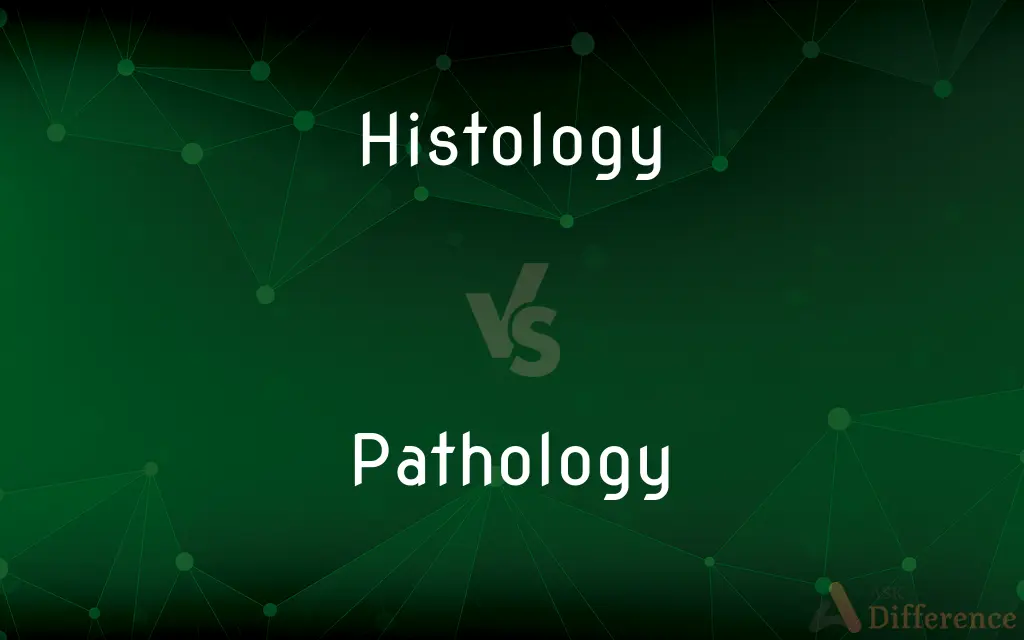Histology vs. Pathology — What's the Difference?
By Tayyaba Rehman & Fiza Rafique — Updated on September 19, 2023
Histology is the study of the microscopic structure of tissues, often for diagnosis. Pathology is the broader study of diseases, including their causes, processes, and effects, which may incorporate histology as a tool.

Difference Between Histology and Pathology
Table of Contents
ADVERTISEMENT
Key Differences
Histology focuses exclusively on the microscopic examination of tissues to understand their structure and function. These tissues can come from plants, animals, or humans. It's a discipline often utilized in medical settings to help diagnose diseases. Pathology, on the other hand, is a much broader field that deals with the entire spectrum of disease, including its causes, mechanisms, and effects on the body.
Both histology and pathology are crucial in medical science, but they serve different purposes. Histology is usually a part of pathology in that tissue samples may be examined under a microscope to assist in a pathological diagnosis. However, pathology also involves other elements such as molecular biology, immunology, and biochemistry to provide a comprehensive understanding of diseases.
Histologists often work in conjunction with pathologists. For instance, a histologist might prepare and stain tissue samples for a pathologist to examine. While histology can offer detailed insights into the cellular structure of tissues, pathology integrates these insights with clinical data and other diagnostic tests to arrive at a full understanding of the disease.
While histology is mainly concerned with the 'what' (i.e., what the tissue looks like and what cells are present), pathology seeks to understand the 'why' and 'how' (i.e., why the disease is occurring and how it is affecting the patient). In summary, histology is a subset of pathology focused on tissue examination, whereas pathology encompasses a broader range of investigations related to disease.
Comparison Chart
Focus
Microscopic structure of tissues
Study of diseases
ADVERTISEMENT
Diagnostic Tools
Microscope
Microscope, blood tests, etc.
Applicability
Medical, botanical, zoological
Mainly medical
Outcome
Tissue structure
Diagnosis and understanding
Interdisciplinary
No
Yes (uses multiple sciences)
Compare with Definitions
Histology
Study of tissue structure
The histology report showed abnormal cells.
Pathology
Study of disease
Pathology helps in understanding complex diseases.
Histology
Used in diagnosis
The histology confirmed the presence of cancer.
Pathology
Can include histology
The pathology report integrated histological findings.
Histology
Microscopic focus
Histology provides cellular-level insights.
Pathology
Encompasses biochemistry
Pathology involves biochemical tests.
Histology
Can be plant or animal
Histology is not restricted to human tissues.
Pathology
Diagnostic field
The pathology report came back positive for infection.
Histology
Requires staining
Staining is a common practice in histology.
Pathology
Examines causes and effects
Pathology studies the etiology of diseases.
Histology
Histology, also known as microscopic anatomy or microanatomy, is the branch of biology which studies the microscopic anatomy of biological tissues. Histology is the microscopic counterpart to gross anatomy, which looks at larger structures visible without a microscope.
Pathology
Pathology is the study of the causes and effects of disease or injury. The word pathology also refers to the study of disease in general, incorporating a wide range of biology research fields and medical practices.
Histology
The study of the microscopic structure of tissues.
Pathology
The science of the causes and effects of diseases, especially the branch of medicine that deals with the laboratory examination of samples of body tissue for diagnostic or forensic purposes
Research people skilled in experimental pathology
Histology
The anatomical study of the microscopic structure of animal and plant tissues.
Pathology
The scientific study of the nature of disease and its causes, processes, development, and consequences. Also called pathobiology.
Histology
The microscopic structure of tissue.
Pathology
The anatomic or functional manifestations of a disease
The pathology of cancer.
Histology
(biology) The study of the microscopic structure, chemical composition and function of the tissue or tissue systems of plants and animals.
Pathology
A departure or deviation from a normal condition
"Neighborhoods plagued by a self-perpetuating pathology of joblessness, welfare dependency, crime" (Time).
Histology
That branch of biological science, which treats of the minute (microscopic) structure of animal and vegetable tissues; - called also histiology.
Pathology
The study of the nature of disease and its causes, processes, development, and consequences; now usually and especially in the clinical and academic medicine subsenses defined below.
Histology
The branch of biology that studies the microscopic structure of animal or plant tissues
Pathology
The clinical biomedical specialty that provides microscopy and other laboratory services to clinicians (e.g., cytology, histology, cytopathology, histopathology, cytometry).
The surgeon sent a specimen of the cyst to the hospital's pathology department for staining and analysis to determine its histologic subtype.
Pathology
The academic biomedical specialty that advances the aspects of the biomedical sciences that allow for those clinical applications and their advancements over time.
Those three pioneering pathologists went on to become leaders in building the pathology departments at several universities.
Pathology
Any of several interrelated scientific disciplines that advance the aspects of the life sciences that allow for such technological applications and their advancements over time.
The plant pathology and vertebrate pathology programs of the university's biology department
Pathology
Pathosis: any deviation from a healthy or normal structure or function; abnormality; illness or malformation.
Some sort of renal pathology was suspected, but imaging and even biopsy found no discernible pathology, glomerular or otherwise.
Some sort of mental and social pathology seemed to sweep over the discourse later that autumn.
Pathology
The science which treats of diseases, their nature, causes, progress, symptoms, etc.
Pathology
The condition of an organ, tissue, or fluid produced by disease.
Pathology
The branch of medical science that studies the causes and nature and effects of diseases
Pathology
Any deviation from a healthy or normal condition
Common Curiosities
Is Histology a part of Pathology?
Yes, histology is often used as a tool within pathology.
Does Pathology only involve tissues?
No, pathology involves a broader range of tests and studies.
What is Histology?
Histology is the study of microscopic structures of tissues.
Can Histology be used for diagnosis?
Yes, histological exams are often used for diagnostic purposes.
What is Pathology?
Pathology is the study of diseases, including their causes and effects.
Do Histologists work with Pathologists?
Yes, histologists often prepare samples for pathologists.
What tools do Pathologists use?
Pathologists use microscopes, blood tests, and more.
Is Pathology interdisciplinary?
Yes, pathology integrates multiple sciences like biochemistry and immunology.
What does a Pathology report contain?
A pathology report includes diagnosis and may integrate histological findings.
Who reads Histology slides?
Histologists and pathologists may both read histology slides.
Can Histology detect cancer?
Yes, histology can be crucial in diagnosing cancer.
What's the primary goal of Pathology?
The primary goal of pathology is to understand and diagnose diseases.
What tools do Histologists use?
Histologists mainly use microscopes.
Is Histology applicable beyond medicine?
Yes, histology can be applied in botanical and zoological studies.
What does a Histology report contain?
A histology report contains information on tissue structure.
Share Your Discovery

Previous Comparison
Mortgagor vs. Mortgagee
Next Comparison
Wardrobe vs. CupboardAuthor Spotlight
Written by
Tayyaba RehmanTayyaba Rehman is a distinguished writer, currently serving as a primary contributor to askdifference.com. As a researcher in semantics and etymology, Tayyaba's passion for the complexity of languages and their distinctions has found a perfect home on the platform. Tayyaba delves into the intricacies of language, distinguishing between commonly confused words and phrases, thereby providing clarity for readers worldwide.
Co-written by
Fiza RafiqueFiza Rafique is a skilled content writer at AskDifference.com, where she meticulously refines and enhances written pieces. Drawing from her vast editorial expertise, Fiza ensures clarity, accuracy, and precision in every article. Passionate about language, she continually seeks to elevate the quality of content for readers worldwide.















































